
ARCHIVED PAGE - PLEASE READ!
This page was written by me a long, long time ago. As such the quality of the writing, photography and/or any conclusions I may have come to simply do not stand up to the levels I consider necessary these days.
I do not believe in deleting things outright though as I feel that these pages form something of a time capsule from an earlier stage in my life, and may still be of some interest to folks who have been coming here for a long time. So instead of deleting this page it has been archived.
PLEASE NOTE THAT THIS PAGE HAS BEEN ARCHIVED, AND SHOULD BE CONSIDERED "FOR INTEREST ONLY" AND NOT BE USED FOR ANY OTHER PURPOSE. LINKS, PRICING ETC ARE LIKELY TO BE OUTDATED AND WILL NOT BE UPDATED.
LumaRay FL6. Rating: 80%

The FL6 is the debut product from LumaRay. It is a plastic bodied LED flashlight, which looks like it was dug out of a toolbox on the starship Enterprise. It's an interesting looking light to say the least, and features a number of clever design features; not least the head release mechanism, which is quite unlike anything I've seen before. So, on with the review.
Product Info:
| Manufacturer: | LumaRay. |
| Available From: | N/A - Obsolete product. |
| Price (as of May 2005): | US$70. |
| Size: | 21.5 x 5.5cm. |
| Number of Lamps: | 6. |
| Lamp Type: | 5mm LED, believed to be Nichia parts. |
| Relative Brightness at Beam Centre*: | 770. |
| Lamp Current: | To be measured. |
| Lamp Colour: | White. |
| Body Finishes Available: | Plastic (GE Xenoy™) - Gunmetal colour. |
| Battery Type: | 3 C-size. Alkaline recommended. |
| Switch Type: | Twist bezel on/off. No intermittent or lockout modes. |
| Water Resistance: | Waterproof. Submersible to 15 feet. |
| Approximate Beam Angle: | 5° (Estimate). |
| Warranty: | 1 year Limited (USA only). |
| Notes: | Light is supplied with instruction manual only, no accessories are included. |
| Review Date: | 8th May 2005. |
| Related Pages: | LumaRay FL6 - 2006 Revision. |
* Relative brightness here is simply a reading taken from the lightmeter on my camera, it's not frightfully accurate, and isn't in any discernable unit - however it allows some comparison to be made between lights reviewed here - I WILL replace this with an actual intensity reading when I get a lightmeter - when I find one I can afford.
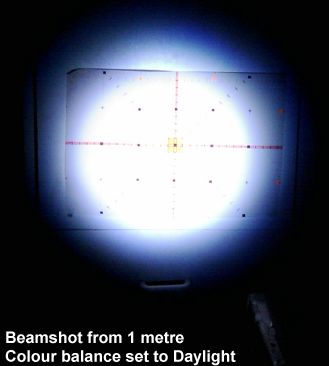
Packing:
Before you even open the box, the originality of the FL6's design is apparent. It is supplied in a box shaped like a triangular prism, which unfolds smartly to reveal your shiny new FL6 and its instructional leaflet, sealed inside a plastic bag. The box only requires a couple of bits of sticky tape to be cut with something sharp (A fingernail will do, especially if you have claws like mine), then a cardboard retaining tab to be removed, then the whole thing unfolds as shown below. There are a number of mysterious holes in the box - these appear to be entirely decorative, as they show nothing of the light inside, but they are an interesting feature nevertheless.

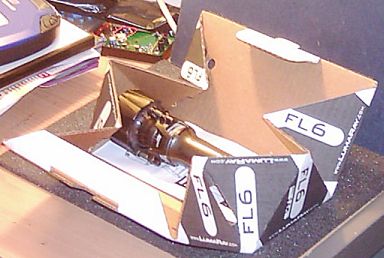
Innovative packing, which doesn't need any heavy weaponry to get into.
Power Source:
The FL6 is powered by three common alkaline C cells. The light is not supplied with them (probably to reduce shipping costs as much as anything), so you'll need to go out and buy some, then install them before you can start testing out your new light sabre...er...flashlight, sorry. Once you have the cells for it, fitting them is relatively simple - the procedure following sounds a great deal more complicated than it actually is - it's far, far more self-explanatory when you have the light in your hands.
1. Stand the light on a flat surface (like a desk) with the bezel pointing up. Locate the locking collar - this is the thing with the three rods from the cantilever assembly attached to it - right at the top of the battery tube. Grip this and rotate it anti-clockwise.
2. Get a decent hold of it, and press downward firmly (this is why it's easier to do on a desk - a reasonable amount of force is needed to compress that spring - yes, the one you can see. It is actually a functional component). The head should now lift itself a little if there are batteries installed, if not, while still holding the collar down, lift it off. The pic below shows you what to get a hold of - despite my thumb being in the way.

3. Dump out the old cells if there are any in there. You may have to shake the light to get them out, as LumaRay have intentionally fitted an O-ring to stop the cells falling straight out. This may seem a bit of a faff initially - but trust me, if you've ever dropped C or D cells on your bare toes when changing them in the dark, you'll realise what a good idea having them unable to fall out actually is! The last one can sometimes be a real pig to get out, requiring the light to be smacked against the palm of a hand or shaken somewhat violently. Simple enough though.
4. Install three new C cells, negative end toward the tailcap. There's a decent spring in there, so you can safely drop the cells straight in without worrying about breaking anything.
5. Press the head back on - if it won't fit, rotate it through 30 degrees or so and try again. Very occasionally the switching assembly will line up incorrectly and prevent the head from fitting. This doesn't indicate a fault - just turn the head and try again. The head will click into place audibly when it's right on.
6. Rotate the locking ring found in step 1 clockwise until it stops to lock everything up. Then you're good to go.
As I said earlier, it sounds a lot more complicated than it is - once you've done it once you'll see what I mean. Carrying out a battery change in total darkness isn't a problem at all (so long as you don't lose the head - which given that it glows would be rather silly!).
I always recommend running lights on a decent brand of cells, despite the price, I am a great fan of the Duracell Ultra M3 type, as they seem to give excellent runtimes in all types of situation. The Tesco cells seen here are just used for photographic purposes as they're all I had handy!
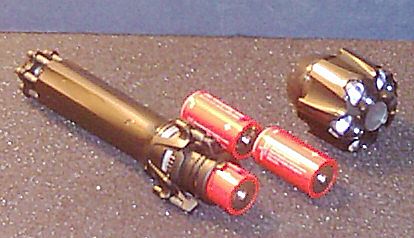
The instruction manual states that the light will run for up to 200 hours on a set of cells, 10-15 hours of that at high brightness. This is a typical alkaline discharge characteristic, and shows that the light does not use a regulator circuit, simply a current limiting resistor (though I'd really need to make a graph to confirm that). I cannot yet comment on the 200 hour figure, but I can safely say that this light will run for a long, long time. 6 LED's do not draw all that much power, and C cells have a relatively high capacity (~8Ah, compared to the ~3Ah for AA cells), especially when a pretty small load like this is drawing power, so you should get a long, long time from the cells. I will conduct a graphed test once I get the equipment to do so - I don't know when that will be however, not even on the cards yet.
I have not had the opportunity to test the FL6 with rechargeable cells, as I do not possess any C size rechargeables. It does not state in the instruction manual that they cannot be used though, and I can't see why they would not. The light may start out slightly dimmer though.
Lamps:
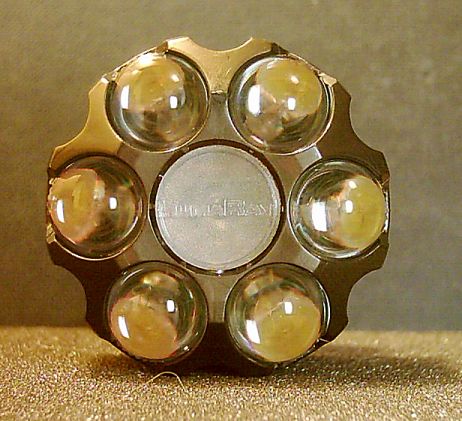
The FL6 uses six relatively common white 5mm LED's to produce its light. The beam from these LEDs is focused into one relatively narrow and smooth beam by individual positive lenses in front of each LED. These lenses also make the FL6 very interesting to look at. One slightly unusual aspect of this light is a "secondary" light source. The inside of the cells in which the LEDs are recessed has been coated with a glow-in-the-dark (GITD) substance, which will glow a ghostly blueish green for several hours after the light has been used, or if it's left exposed to a strong light source for a while. This is designed as a locator beacon for finding the light in a darkened room. And it works very well. This glow can easily be seen in total darkness from the far side of an average sized room at least five hours after the light was last used. I might add, it caused a distinct double-take the first time I woke up and saw it on the flashlight shelf, glowing away to itself happily.

Looks really cool too!
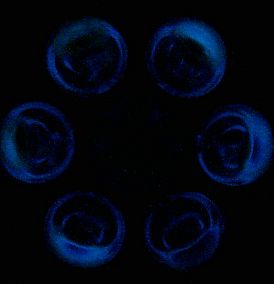
Operation:
The FL6 is a very simple light to operate. No fancy multi-function switches, no brightness level controls or anything. Just a conventional twist-bezel switch. Holding the light so that it's facing away from you (because shining it in your eyes ain't such a good idea - it's quite bright at close range), simply twist the head anti-clockwise (or the body the other way) to get light, and turn it clockwise to get not light. Simple as that. There is no momentary (signaling) operation mode on this light, so don't look for one, nor is there a lockout function. Though I don't find this type of switch too prone to accidental activation anyway, so it isn't a great loss.
Ergonomics:
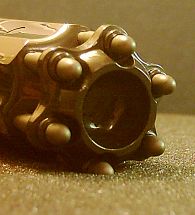
It has to be said, that the FL6 is an unusual looking thing. There are a lot of exposed functional things - a big spring for the release collar, ball joints for the same, and the aluminium pins on the tailcap. Despite these things however, the FL6 is actually very comfortable to use; whether in a conventional or a tactical grip. The body is slightly tapered (wider at the tailcap than at the top of the barrel), and just the right diameter to feel comfortable in the hand. It's just the right weight too, heavy enough to feel reassuringly solid (especially for a plastic bodied light), yet not heavy and clunky like many metal bodied lights this sort of size can, the point of balance being just on the join between the head and body, so it's perfectly balanced in your hand. Despite the smooth texture of the body, the aforementioned shape combined with all the things to get a hold of on the head mean that keeping hold of the light with wet, cold or oily hands shouldn't be too hard. Some texturing *would* help though. However, keeping hold of lights is what lanyards are for, and while the FL6 is not supplied with one, there are a number of attachment points for one provided on the tailcap.
The only ergonomic downside related to the rather nifty looking release mechanism for the head. While it looks good, it also loves to catch on things, especially pockets when you're trying to get the light out in a hurry. That and that fluff just loves to accumulate behind there too. It's not a major gripe, but it can be a little frustrating when you go to get the light out and it decides to stop to have a conversation with your pocket first.
The aforementioned linkages on the release mechanism combined with the flutes in the head serve as a very simple but effective anti-roll device. If you put this light down on any surface it'll stay put, rather than rolling off into the distance like some other lights can.
The switch position works well, and unusually for this type of switch, it is actually quite easy to operate the light one handed. Granted, it's a bit stiff when trying to use a finger or thumb to turn it on or off, but not overly so.
Performance:
This is the first area where the FL6 does run into a bit of trouble. Not drastically, but it doesn't score as well here as in a lot of other areas, for one very simple reason: this is a pretty big light to only be using 6 5mm LED's.
The LEDs in this light appear to be of high quality, producing one of the whitest beam I've seen from a non-Luxeon based LED light, producing a very pure white beam, with just a slight blue ring at the edge of the beam caused by the optics used here. They're bright too, for what they are. However, they can only produce so much light. And many people will say the same; this is a big light for what it does.
In the same breath though, you can throw in another argument. Some lights are made to be stunningly bright, but they only run for half an hour. Whereas other lights aren't very bright, but will keep going until Doomsday before needing a battery change. This one falls into the latter category. I know which I'd rather be carrying with me when the aliens invade, or civilization as we know it is wiped out by the next ice-age.
The FL6 doesn't make life easy for itself here either, in that it very nearly falls into the trap that Inova did with the X1 - luckily it gets away with it, but only just. What I mean here, is that it's a narrow beam with a very sharp cutoff at the edge, and relatively little sidespill - best for spotting things at a distance - like from the far side of a room. The Inova X1 had a beam much like this, but it only used a single LED, as a result, at that sort of distance, it wasn't actually bright enough to be of any use for much. The FL6 at least is bright enough for the beam to still be fully useable at that sort of distances. The lack of sidespill however doesn't make this the idea light for walking around the house with, as it can lead to "tunnel vision" to some extent. It isn't as bad as some lights I've encountered in that respect, but that is something you may way to take into consideration. It would be handy however in a situation where you need to produce as little interference as possible - attendants in a cinema for example, allowing them to see what they're doing without distracting too many other people.

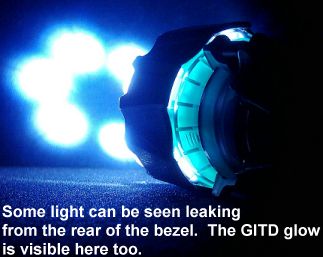
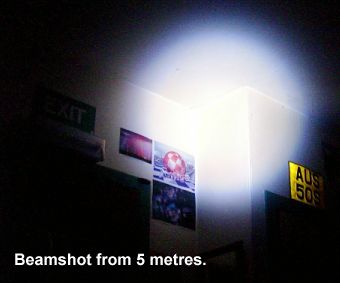

Okay, it doesn't produce as much light as a Surefire M6 - but an M6 can't make 200 hours between battery changes, can it?
Durability Department:
Okay. Take those visions of the £1 plastic flashlights which shatter the first time you drop them, and get them out of your head right now. This thing is tough. This isn't quite so surprising when you take into account that the light here is made of a combination of GE Xenoy (body), polycarbonate (optics), stainless steel (contact springs) and high grade aluminium (tailcap pins and balljoints on the head release mechanism). This is really about as though as plastic bodied lights get.
The usual impact tests were conducted; firstly dropping the light from waist height to the floor (thinly carpeted wood), secondly throwing across the room from the same height - imitating losing hold of the light when running with it. It shrugged off both of these tests without even breaking a sweat. Though it *did* roll under the bed after the second test, and took me twenty minutes to get it out again. I wouldn't want to try running this over with a car, or throwing it off a cliff, but I can safely say that it'll shrug off everyday mishaps without trouble. It *will* however pick up scratches quite rapidly if it's kept for example, in a toolbox though. That won't affect the operation of the light itself, but scratching up the optics will broaden the beam.
The light is sealed at the head by no less than two O-rings, and is stated in the instruction manual as being waterproof to no less than 15 feet. It survived spending three hours submersed in the bath here, so no worries there about using it in foul weather. Probably best not to take it diving though as it's only rated to 15 feet. The lack of complex electronic drive circuitry means that even it the light did floor, so long as you dry it out pretty quickly (and rinse it out properly with clean water if it got salt-water in) before reassembling it you should be fine. The contacts are stainless steel, so should resist corrosion even in a situation like that. Occasionally lubricating the O-rings with silicone grease should be all that's necessary to maintain the waterproof rating.
Plastic bodied lights don't get much tougher than this.
Overall:
Overall, the FL6 is a well engineered and nicely put together lighting instrument. It's really nice to see a device like this where someone's taken the time to design something which looks a bit different, yet still works well. It is quite a large light for the amount of light it produces though, but the long runtime in my view balances that out to a point. The lack of sidespill inherent to this sort of optical arrangement is of more concern though as it can affect the light in everyday operation.
LumaRay appear to realise this though, as there is another model in the pipeline (may actually be available now, will have to check) called the FL12, which replaces the white disc in the centre of the bezel with another 6 white LEDs. These produce a large amount of sidespill to go with the highly effective spot - that would make a much more user-friendly light for those not needing just the clean spot.
The design and build are of a very high quality though, and that shows.
Pros:
+Unique and appealing design.
+Uses cheap and easy to find batteries.
+No bulbs to burn out.
+Easy to use.
+Durable.
+Quick release system works really well.
+GITD locator feature
+Good long runtime.
+Feels great in the hand.
Cons:
-Narrow beam can lead to "Tunnel Vision".
-There are brighter lights this size.
Niggles:
>Backspill from the bezel may be of concern to some users.
Ratings:
Beam Quality: 6
Build Quality: 10
Battery Life: 9
Durability: 8
Value: 7
Overall: 40 / 50 = 80%
Many thanks to Ed of LumaRay for providing this review sample!
Long Term Testing:
20th April 2005: Received light this morning. Put this page up, and am in the very early stages of testing. Excuse the lack of photos, camera's batteries just died!
8th May 2005: Uploaded review in full. Rating finalised.
5th January 2021: Page retired and moved to Site Archive.
28th April 2023: Revised Statcounter code to allow for HTTPS operation.
13th April 2025: Removed a couple of dead links as the manufacturer's website is no longer operating. Also tweaked image formatting a bit to improve readability on mobile devices.